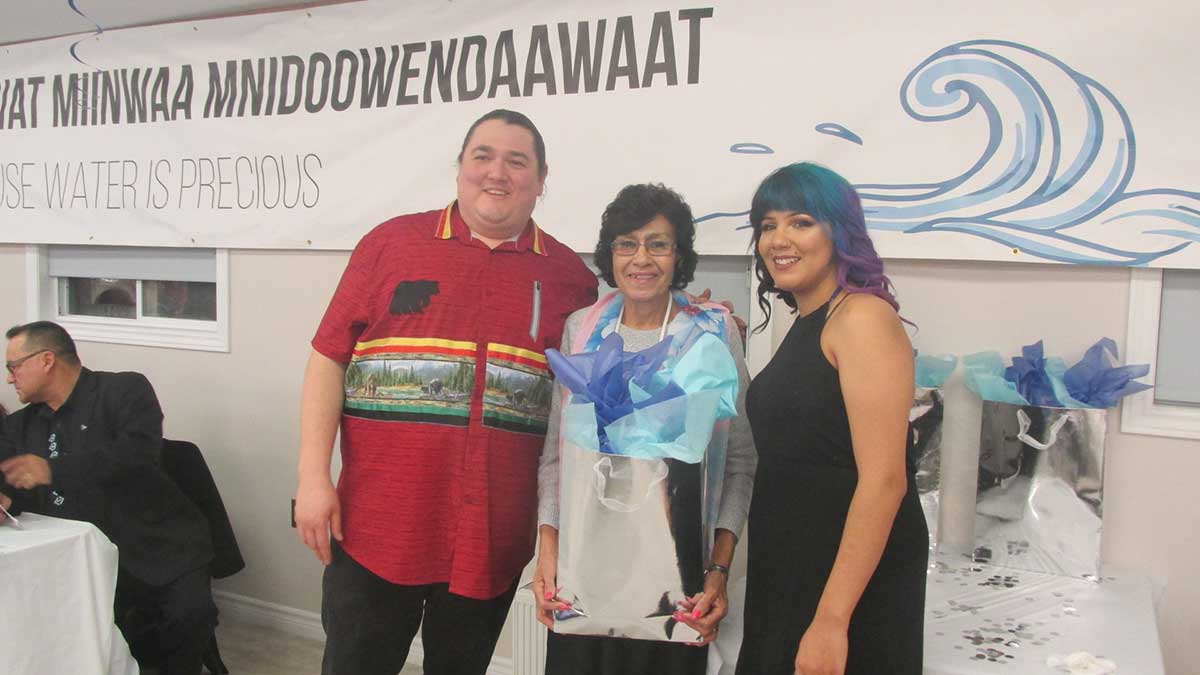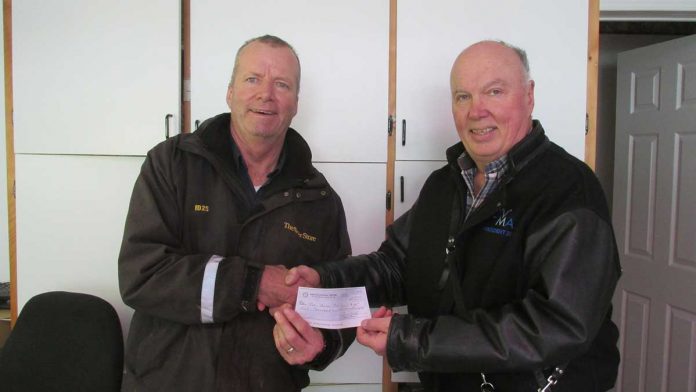ZHIIBAAHAASING – The community of Zhiibaahaasing First Nation held a celebration this past Friday evening as part of its water week events to recognize the community members for their involvement in the Swim Drink Fish program. The events celebrate the excellent results that came out of the program highlighted by the monitoring last year at three beaches indicating they all meet quality standards. The celebration also feted those who took part in and helped with the Native language program. As has been reported previously the sampling and monitoring of water in Zhiibaahaasing and Cockburn Island last year was a tremendous success.
“Water is very important, we need it to drink and use, and for healthy animals and land,” stated Grand Council Chief of the Anishinabek Nation Glen Hare at one of the celebrations. “Water has been taken for granted for too long, but without water we wouldn’t be here. I think of water walker Josephine (Mandamin) a lot when I think about water. Now her niece Autumn (Peltier) has taken over this responsibility and is looking over this. Autumn started advocating for clean water and on climate change when she was 14 and now she is 15. She is helping to change the world. But where are our government people on these issues? Autumn was in New Zealand at a World Economic Conference recently speaking on the importance of climate change, but who was there for Canada? Our government reps need to be stronger supporters of water.”
The Grand Council Chief noted that the Saugeen First Nation recently voted against a deep geological repository at Bruce Power, “even though they were offered $150 million from Ontario Power Generation (OPG). It was the right decision. We have two elders here in this community (Bill and Ken Antoine) and (Chief) Irene Kells. We are the keepers of the water and should never forget this.”
“We have to respect water, water is life, and it gives life,” said Grand Council Chief Hare.
Patrick Madahbee was the master of ceremonies for the evening celebration-dinner and he introduced Zhiibaahaasing Chief Irene Kells.

“I would like to welcome our Grand Council Chief Glen Hare and the regional director of Indigenous and Northern Affairs Canada (for Ontario) Anne Scotton and our emcee Patrick (Madahbee) to come out and join our community here tonight to talk about this special project that is taking place in our community and all the support we have been given. It’s a great day.”
“The hall looks beautiful and we had a beautiful dinner. I want to acknowledge all those who helped put this evening on,” said Chief Kells. “This is a very special event and I’m so happy all the children are here who took part in the program. They are our leaders of the future. The two leaders/elders who took part in the language part of the program, Bill and Ken (Antoine), helped speak and teach the Native language to the children. We also had adults, teens and parents who participated.”
Chief Kells noted the Swim Drink Fish program began in the community about a year ago. “It has been amazing seeing the kids getting excited about all of this, learning about the need to protect water. I have asked the kids what they learned and they said they learned to look after the water, not to through garbage in the water or on beaches.”
“Chelsea Antoine taught the children to look after the water and take care of it,” stated Chief Kells. “I can’t thank her enough for the work she and others have done in the program.”
Bill Antoine along with his brother Ken, who had helped teach the children in the community through the program said, “we must protect our water. Because water is essential to all of us.” As for his help in teaching the children the language through the program, “it has been a lot of fun, and to hear the children say words correctly. I’m happy that I’ve been able to take part in this endeavour.”
“I would like to thank Bill, Ken, Irene, and Chelsea and all those that took part in the program, Chelsea and Swim Drink Fish Canada’s Jessica Gordon who is here tonight and Grand Council Chief Glen who has been a strong advocate for us on many issues, such as the protection of water, and is always supportive,” said Mr. Madahbee.
Mr. Madahbee noted in introducing the next speaker, Ms. Scotton, “has been a big supporter of our communities. She has always stepped up to the plate for us. She has been instrumental in her support of our communities here and in Ontario.”
Ms. Scotton thanked all those who participated in the program and the community itself. “It’s all about water and working together to get things done right and protecting this resource. Water is life. This small community is certainly doing its part to make sure water is protected. Thank you for the opportunity to share in this evening.”
“It has been a real community effort,” continued Mr. Madahbee. “It has been driven by the folks in the community, especially Chelsea Antoine, along with many others, the chief, elders and youth have been involved in this project. It has been very exciting. There is still work to do but it has been a real collaboration of everyone in the community.”
Chelsea Antoine provided a video slide presentation of the monitoring project in 2019. She explained through the support of Swim Drink Fish and the participation of the community youth water monitoring had taken place at Gaanogwong Apgishmok, Sandy Bay and Rocky Bay beaches. These beaches were chosen because they are important for recreational activities, drinking water and for swimming.
“At every beach five samples were taken (each time the monitoring took place) with one duplication to make sure that the field methods were done correctly,” said Ms. Antoine. “The samples were taken in whirl paks of 100 millilitres and then taken to the lab for more processing and results.
The Gaanogwong Apgishmok beach was sampled 21 times and passed all standards; the Rocky Beach was sampled 11 times and passed 100 percent each time; and the Sandy Bay Beach was monitored 10 times and all standards were met. “All the beaches passed all the sampling 100 percent of the time,” said Ms. Antoine.
However, she did point out, “I was surprised how much these little beaches accumulated in terms of cigarette butts, treated wood and beverage cans. Monitoring will continue on all three beaches in 2020 and 2021.” Ms. Antoine recommended a garbage removal program be established for Gaanogwong Apgishmok and Rocky Beach with a focus on beverage cans and bottles.
Ms. Antoine explained a Zhiibaahaasing booklet is being created with youth and what they have learned about Native language, the medicine wheel, four directions, and drawings and messages from the children. One of the messages reads, “without water nothing would exist,” and another reads, “I love swimming and when I see pollution in the water it makes me sad.”
Ms. Antoine then made a presentation to all those who had helped in the program, including for one Jon Riberdy who helped her operate the program.
Regional Director General Scotton had told the Recorder prior to the celebration she was in the community “to meet the chief and council and talk about issues. We try work together to see what the community wato nts to do and how we can help. It is always better to meet and discuss all of this first-hand.”
“We arrived in the community earlier today and got to take a tour of the community, meeting the chief and council,” said Ms. Scotton. “We’re very happy to be here tonight to help the community celebrate this program,” she said. She had attended along with Frank Monozial, capital management officer with the Ontario region of Indigenous Services Canada.
The local water quality hub as well as several others in Ontario were created by Swim Drink Fish with $1.8 million in funding from Environment and Climate Change Canada’s Great Lakes Protection Initiative. Volunteers help hub co-ordinators collect water samples in places where people swim, boat and hold ceremonial activities, according to a press release. Swim Drink Fish analyzes the samples and informs the community if the water meets established standards for recreational water quality. The results are published in the Swim Guide (www.TheSwimGuide.org) or on an Apple or Android app.









